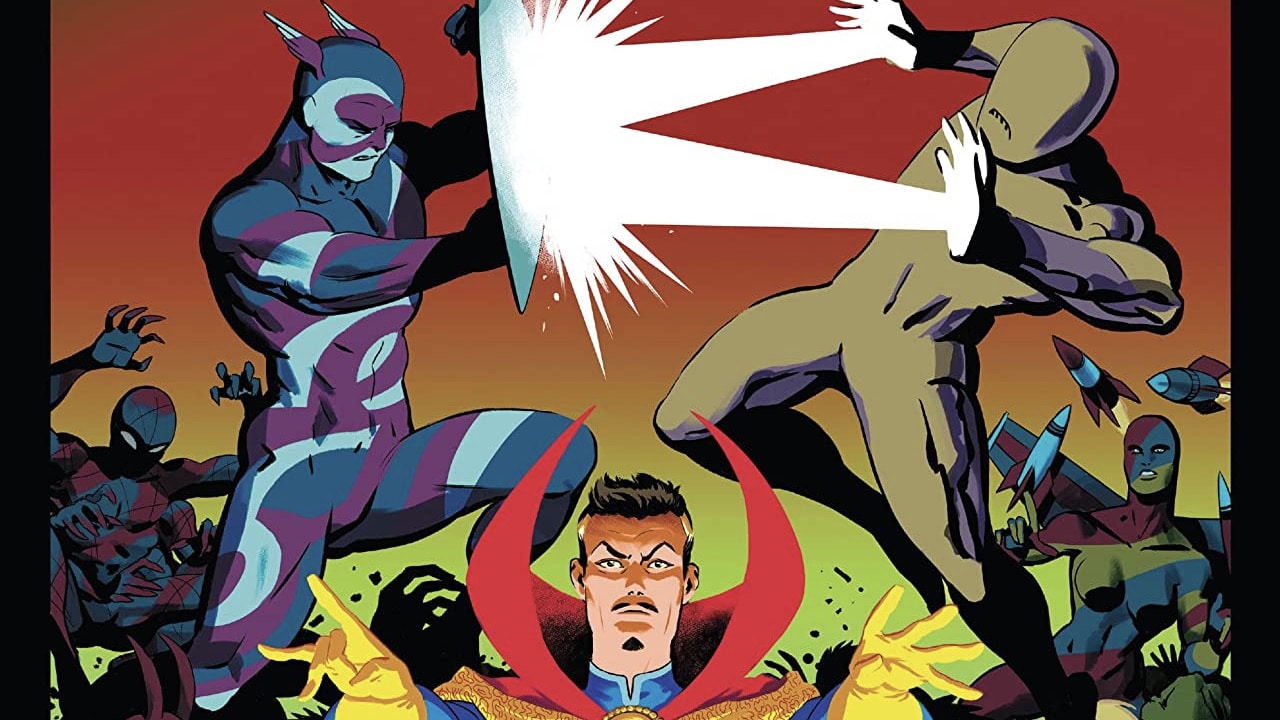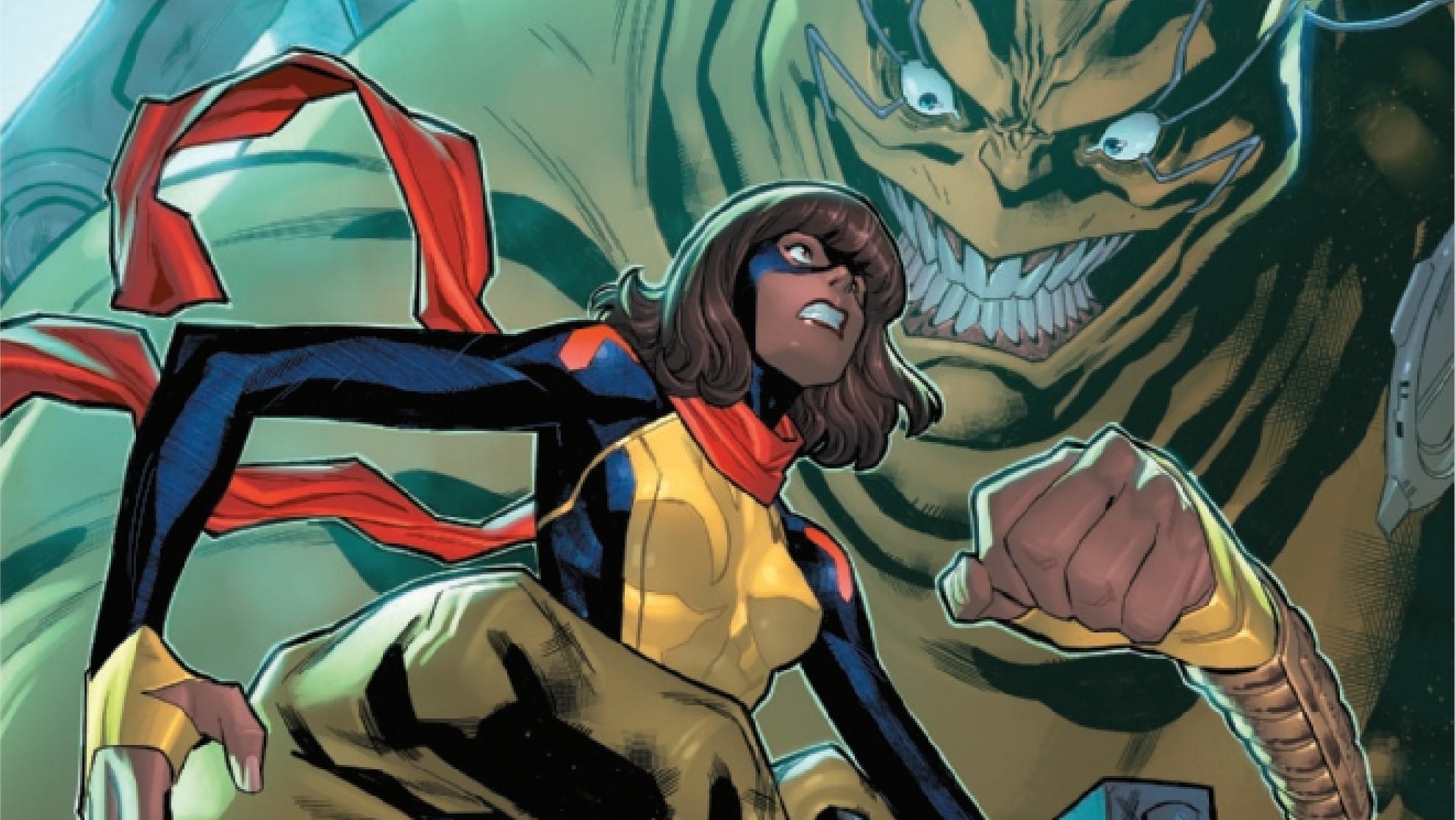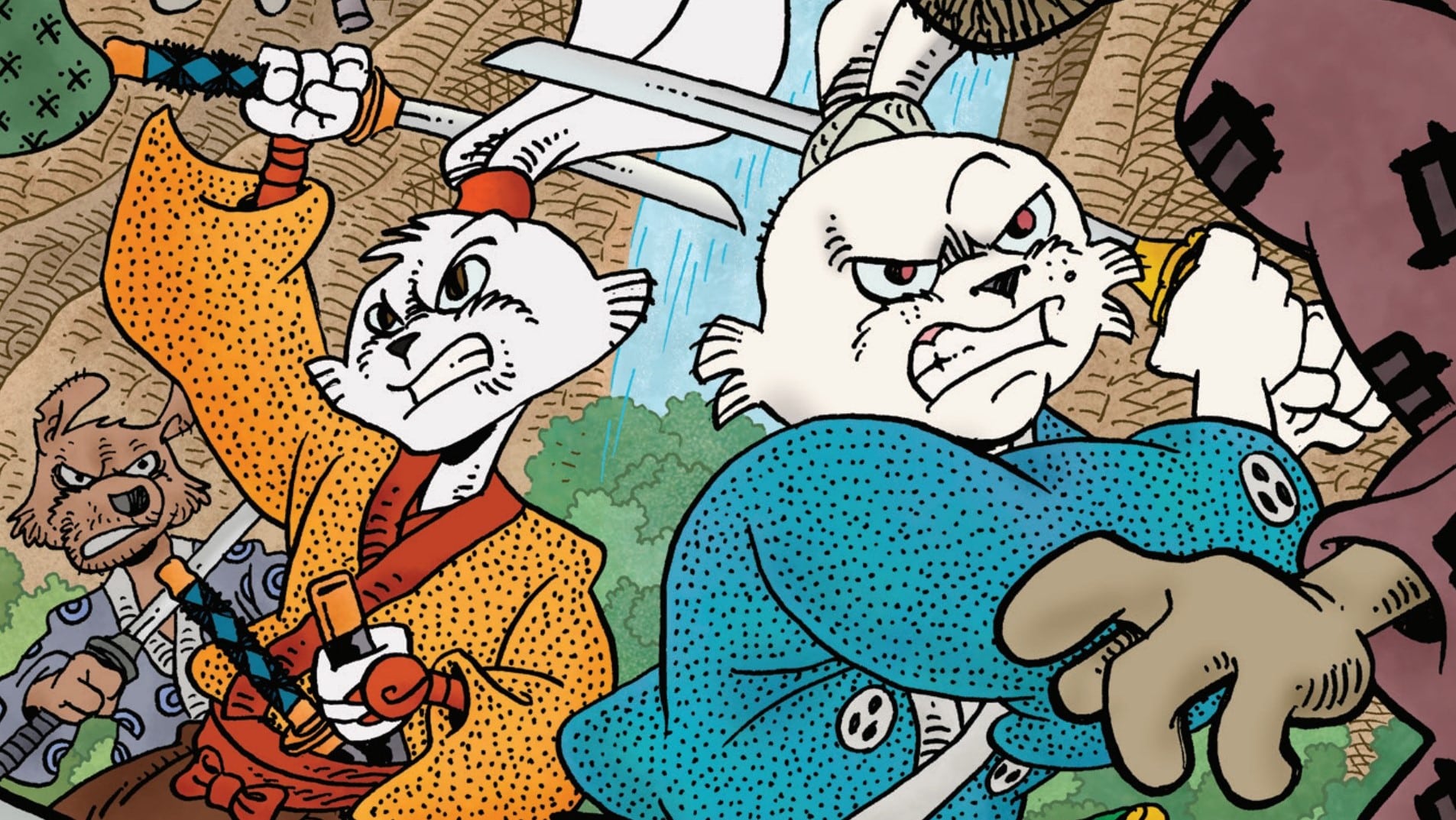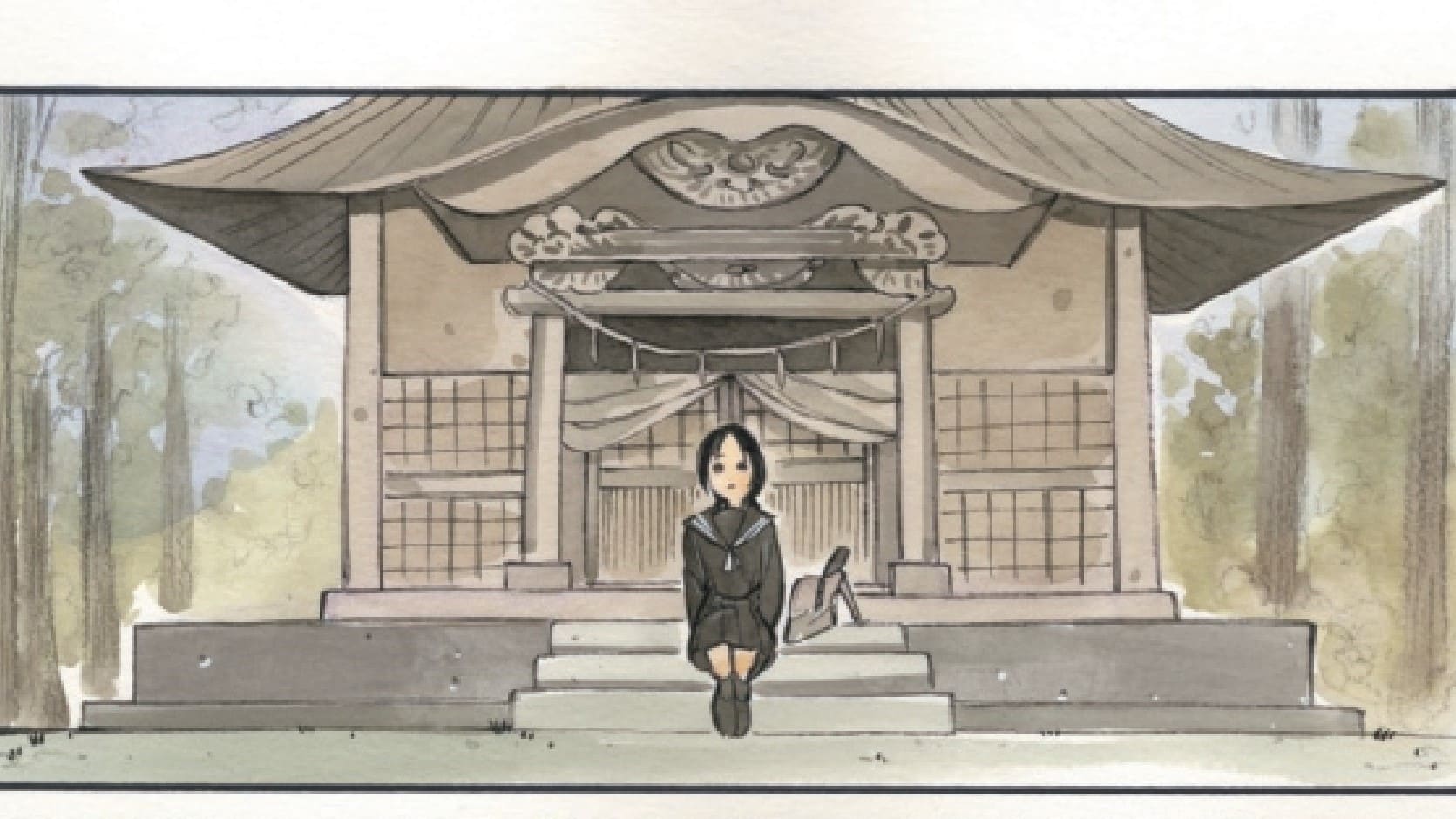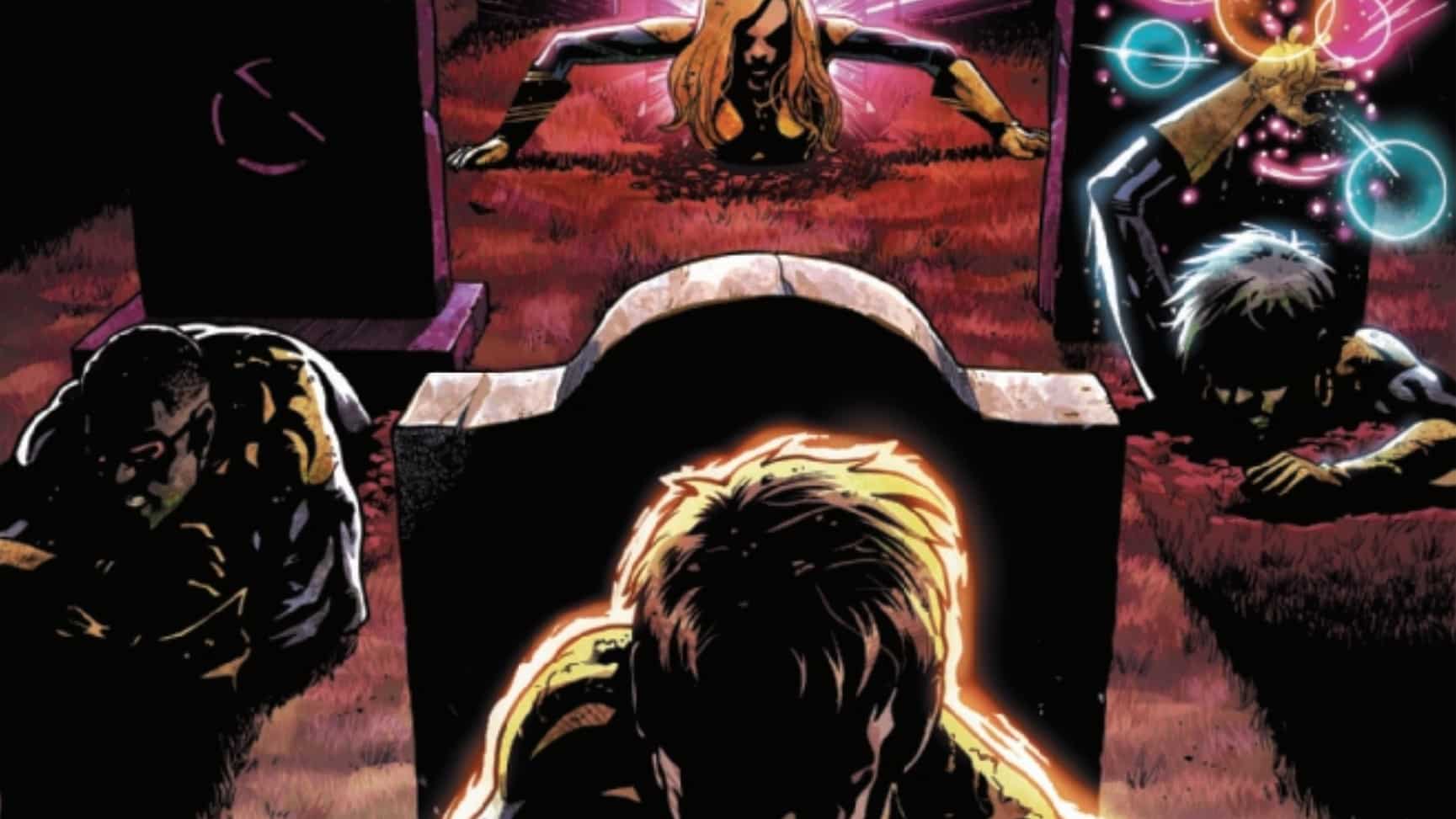Our fearless Defenders find themselves on the third stop on their multicosmic journey: The archetypal FOURTH COSMOS! Get out your Blake. And your Jung. And your Silver Age Omnibus. Defenders #4 is told to us by Al Ewing and Javier Rodriguez, with lettering by Joe Caramagna.
Mark Turetsky: Welcome to the Fourth Cosmos, Stephanie! I hope we survive the experience.
Stephanie Burt: Where are we? Is that Jim Steranko over there in the corner? Is it 1967? I spy with my little eye a yellow submarine…
Blue, Blue, Electric Blue

Mark: So, if the Sixth Cosmos was super-science and the Fifth Cosmos was magic, this Fourth Cosmos is based around archetypes. As always, we begin the issue with our point of view character (here it’s Cloud) inverted, mirroring their magical Tarot representation. In this case, it’s The Lovers, Inverted.
The other thing I’ll point out right up front is the different printing style: the pages are yellowed, the coloring suggests halftone printing (the old-timey look where the image is made of different-sized dots of different colors), and we even get color bars on the page! Color bars, or color control strips, are printer’s marks that allow a printer (the kind that’s a person who makes prints, not the kind that’s a machine that jams paper) to see that all their different colored inks are aligned on the page and aren’t miscued or low on ink or what-have-you. But there they are, right on the page in the “safe” area!
I’ve been banging on about Javier Rodriguez’ use of primary printing colors since issue #1. The magic of the Marvel universe in this series is explicitly colored as cyan, magenta, yellow and black (with white representing the color of the empty page, the substrate of their universe, as it were).
Okay, I’ve gotten ahead of myself here, as often happens with this book.
Stephanie: That’s OK. I think I’m behind. I’ll go anywhere Cloud goes, though.
Mark: The first beings our gang encounters are the “One-Is-Four” and the “Four-Are-One.” One-Is-Four is a kind of Hulk creature with four heads, each communicating solely with one of the primary printing colors. The blue is likely inquisitive, the magenta is happy, the yellow is sad and the black is angry. They have a failure to communicate (a Shaka When The Walls Fell, if you will). The One-Is-Four speaks cyan to the Defenders, and Cloud, attempting to respond, speaks green, which is not one of the “accepted” colors that are spoken in this cosmos. So, it being a monthly superhero comic, they fight.
Stephanie: I’m glad you brought up Darmok, because there’s a definite Darmok feel to this whole issue. A code made of colors and numbers — and, as it turns out, character designs! — whose key lies elsewhere. A Key to All Mythologies, maybe. Or just a long run of Hulk comics. Hey, doesn’t the actual Earth-616 Hulk have at least four personalities, or versions, or heads? Are Ewing and Rodriguez arguing that all superhero comics are basically conflicts among archetypes?
Mark: The Four-Are-One shows up to break up the fight. They have four bodies, but one self, broken up into feminine, masculine, rectilinear and bloblike.
Stephanie: The four genders! Masculine, feminine, rectangle, blob.
Mark: The primordial shapes aspect of Four-Are-One seems to be a manifestation of the Bouba-Kiki effect, which works like this: Someone is presented with two shapes. One is spiky, the other is more rounded. The subject is then asked which one is Kiki and which one is Bouba. With remarkable consistency across languages and cultures, the spiky one is Kiki, the rounded one is Bouba. I should point out that this effect has its limitations, and is lessened across the spectrum of neurodivergence, as well as being absent in people who are born without sight.

Mark: Still, for the purposes of this comic, they represent a kind of linguistic primordialism. I should also say that I grew up in a bilingual family, speaking both English and French, so the concept of linguistic gender isn’t foreign to me, but that’s not a grammar that’s universal to all languages, and, let’s say, it’s a rather fraught concept.
Stephanie: Big fan of the Bouba/Kiki effect over here, since I study poetry, and the effect is about how sounds carry meaning. We should talk about Zota, though. And about Javier Rodriguez’s extraordinary and cartoony pencilling. Even more than the last issue, this Defenders comic simply does not look like a superhero comic. It looks to me like a psychedelic, art-driven, somewhat shakily mythographic parable from, specifically, about 1966-68. Except for the masculine part of the Four-Are-One, who looks alarmingly like Dr. Manhattan. And yet this comic is going to be about Marvel comics… about their history… which in most accounts begins with a particular Four-Are-One that includes a man and a woman and a rocky spiky dude and a flying youth who represents change…One might call this particular Four-are-One Fantastic.
Mark: Agreed 100%! If this series is about exploring the generic makeup of Marvel, issue #2 gives it its science fiction roots (specifically, through Fantastic Four, as well as Taiia’s 60’s counterculture lingo by way of Kirby’s Forever People, embodied by the Silver Surfer). Issue #3 was magic by way of horror comics, starring our Hulk analogue Harpy. This is something else though. This examines the very nature of the conflict -> resolution -> return to status quo as a kind of stasis for cape comics. A promise of the all-new and all-different, resetting to the all-same.
As for Rodriguez, take a look at his social media avatar: The man is made purely of cyan, magenta, yellow, black and white.
Stephanie: As I reread I’m starting to see the greatness, the true ambition and the oddity in this comic. I’m also starting to see why it’s not quite my bag: these characters aren’t really characters, but illustrations of cosmic narrative principles. And without the context of so many previous comics, it doesn’t make sense. With that context, though…. *steps back in awe*
Mark: The Four-Are-One bridges the language barrier with a set of colorful “streamers” that connect to the Defenders and allow them to communicate. When the Four-In-One speaks, their lettering begins with a yellow bullet, followed by text in cyan and magenta (the vowels are magenta, the consonants cyan), ending with a black bullet in each balloon. They warn that while recurring conflict recurs, there’s a new element that they don’t know how to handle. The recurring conflict is encapsulated by Of-Past and Of-Future disagreeing, other concepts taking sides and then the two sides duking it out.
But this primordial Civil War (and it’s also a Secret Wars [2015]) gets disrupted by a new, strange/Strange element that has popped into existence. It’s Zota, who’s arrived in this Fourth Cosmos and joined forces with What-Must-Be, this cosmos’ version of Galactus/Omnimax. It’s the standard monthly comic book conflict, thrown out of whack by an event/crisis/thingsthatwillneverbethesame.
Stephanie: Our friends Chris and Christi have something to say about that. But you’re right: our heroes have found themselves in a space that’s like the collective four-color brain of an omni-comics creator, connecting past and future, or maybe Days of Future Past, though it feels a lot more like the trippy, soft-focus Moody Blues album of that name (down to the cover art!) than like the hard-edged, character-focused Claremont-Byrne joint of that name. No wonder Taaia talks like a groovy musician, or maybe like Zoot from the Muppet Show: the Four-Are-One are “trying to pick up what we’ve ben laying down.” Heavy.
What’s wrong– what needs to change– in this realm of archetypes is the nature of change itself: when all you have are archetypes, or monthly superhero comics publishers, change doesn’t happen. You only get, as Cloud says, “the illusion of change.” Which is what Stan Lee famously said, or supposedly said, Marvel Comics ought to provide.
Mark: Our illustrious colleague Zach Rabiroff (who’s also our editor, hi Zach! Sorry this is too long but also not sorry!) [Ed. Note: Oh, no, I’ve been perceived.] noted that this whole issue can be read as a parable about Kirby’s New Gods, that what we get here is the earth-shattering status quo change that Kirby wanted to do at Marvel, specifically with the Mangog Saga in Thor, but Lee rejected because it was too big a shakeup. After all, we’re here in the Fourth World/Cosmos.
Stephanie: I generally support Zach in all his decisions, especially since he is our editor. If he says it’s about Mangog, then Mangog it is.
New Words That Only They Can Share In

Mark: Zota has stolen the mask of Never-Open, the enemy of Four-Are-One, who is a primordial archetype of Doctor Doom (so the concept of a team of four being at odds with Doctor Doom is not just a foundational concept in the Marvel Universe, it’s something baked into the fabric of that universe, like Planck’s constant or the speed of light).
Stephanie: Right right. Same way there are Spider-people everywhere.
Mark: The Masked Raider decides to go full kyodai hero and fight What-Must-Be. But Masked Raider’s power is only to make him the equal of everyone he fights, which only means they’re now fairly matched, and the fight does not go well. In the last moments, Cloud introduces the Fourth Cosmos to the concept of love, and in so doing, creates a third form for themselves, a synthesis of the masculine and the feminine. What’s interesting to me here is that Cloud’s new shape isn’t an instead of it’s an in addition to. But I’m sure you have better words to discuss this than I do, Stephanie.
Stephanie: William Blake had better words. I just have, well, different words. And words, in this comic, are sometimes part of the problem: they encourage premature rationalization. A backwards A-to-Z approach, as it were. A Zota approach. What’s needed, apparently — what the universe needs — is words and pictures that work together, like the colored speech of the One-in-Four, or like the opposites that blend together and cycle or spiral and create change in the archetypal cosmology of a William Blake, or a Wiliam Butler Yeats. Which opposites — interacting to create novelty — look like the Jungian animus and anima, I guess, or just like masculine and feminine, if you’re into that. As a girl who mostly digs girls, I’m not entirely happy with the idea that creation must come from masculine meeting feminine. And I’m not in love with any conflict resolution that (put into words) just says that Love Is the Answer. But if Cloud goes there, I’ll follow.
Mark: And notice how the color control strips in this sequence begin to blend with each other, making new colors. And there’s some color theory I need to talk about here. There are two types of color mixing: additive and subtractive. When you pass light through color filters, you have subtractive color mixing. It’s subtractive because you’re talking about taking white light, which contains all visible colors, and removing some of them from it. So, the main primary colors we deal with in this form are cyan, magenta, and yellow. Cyan lets through green and blue, magenta lets through red and blue, yellow lets through red and green. These seem counterintuitive if you’ve grown up with the trio of red, green and blue as primary colors, because we don’t think of, say, yellow as being a mix of red and green, but I guarantee that it works.
Anyway, if you mix, say, magenta and yellow filters, you filter out everything but red. And so you have red. Cyan and magenta give you blue, and cyan and yellow get you green. And now you have the three primary colors that we learned about in kindergarten. These are your three additive primary colors. And I’ve gotta see something intentional in that, in this story about synthesis and amalgamation, where the solution is to introduce these archetypal characters to the concept of love and adding to, instead of conflict and subtracting from.
Stephanie: I couldn’t agree more, although… although… when you’re seeing a quasi-religious monomyth kind of story about the nature of love and the principles of optics, I’m still seeing a story about the history of cape comics, in which the true heroes have to get past the illusion of change, with its constant demand for fights, and tell new stories about real change, which involves making new collaboration, and growth, as well as “love.” The antagonist, the figure of Never-Open, who demands constant zero-sum fights, has the power to cancel out anything that looks like progress and growth in cape comics, because he has the power to make it so that comics never get opened.
Mark: I don’t think it’s a coincidence that Never-Open is a form of Doctor Doom, who presided over the destruction of the Marvel Universe back in 2015. And that Zota steals his mask in order to bring about the end of this cosmos.
I could also mention that the additive colors (your red, green, and blue) are the colors used in video screens. So maybe Ewing and Rodriguez are saying something about the promise of the future of digital comics. But maybe that’s just reading into things way too much. Still, this comic invites this kind of far-out thinking!
Stephanie: Sure does. It’s also engaged with the arguments that comics constitute a kind of language unto itself: “If we cannot be described in words,” Cloud says, “then we can learn new words.” Which also applies to Cloud’s delightful and cosmically powerful mixture of genders. I’m not sure, though, that this comic has a lot to say about digital media, or about new tech: I detect far more interest in the history of comics — if we go back before, as well as looking after, the Silver Age (the Marvel status quo from which Stan Lee decreed [Ed. Note: Apocryphally] there could be no change), we get superheroes who dress and act like the Masked Raider. Visually he’s a throwback, just as the page-printing gimmicks signal a throwback.
(Small grumble: I kinda maybe slightly dislike the vibe of “Kirby and Ewing and Rodriguez team up for the first time ever against the mighty Marvel Status Quo of Stan Lee, Jim Shooter and the Illusion of Change,” because “superhero stories should focus on love and dispute resolution and real, lasting change in the characters, with fewer fights and fewer status quo resets” is… well…. Claremontian. But it’s also true.)
You Promised Me the Ending Would Be Clear

Mark: And our primordial heroes unite and fight off Zota, who blinks out into, you guessed it, The Third Cosmos (is it just me, or am I sensing a pattern here?). The proto-Galactus What-Must-Be transforms (in much the same way Galactus did in Ewing and Rocafort’s Ultimates) into the golden What-Can-Be, reenacting the conclusion to Secret Wars (2015) by declaring, “Everything Lives,” and summoning the sentience of The Fourth Cosmos.
This embodiment of the cosmos is especially notable, because it’s the sole Cosmos that didn’t show up in Ewing/Foreman’s Ultimates #100. It repeats what is said about it in that issue. It is The True Believer, The Pilgrim. It stops short, though. In Ultimates #100, the captions say that it “Journeys Into Mystery.” The Fourth Cosmos will end, bringing its archetypes to “The Heart of Creation” and its energy will re-form as the Fifth Cosmos. Cloud decides to stay behind, to become an archetype who will become unbounded in a way impossible in their home cosmos. But they promise to meet with the other Defenders again when they reach “The Mystery.”
Stephanie: I’m gonna miss Cloud. But Journey into Mystery? Really? I came to Defenders expecting the title — because of its history, and because of Cloud — to be just super incredibly gay and maybe a little bit trans. Instead it’s something else entirely: the trans nonbinaryness of Cloud is a Jungian hermaphroditic conceptual thing organized by the gender binary, and we are reading a superhero comic book about the history of superhero comic books, to the extent that it doesn’t make sense unless you get the references and the history.
Imagine how different the group fight scenes would look to someone who didn’t recognize Captain Britain and Captain America and Thor and is that Hank McCoy and Magneto? None of these characters are characters: they’re archetypes, spiritual embodiments, meta-creations, talking about how comics need to move forward and incarnate real change while being composed entirely of references. It’s very modernist!
Mark: Personally, I love Thor-Whose-Head-Is-A-Thunderstorm!
Stephanie: My friend Douglas Wolk was the first person to tell me I should bow at the altar of Ewing, and he’s not wrong, but I kept imagining how he would read this comic. I also found myself thinking about a word that he apparently coined like a decade ago: “super-readers,” readers able to bring to superhero comics a startling knowledge of prior superhero comics. Defenders is a comic for super-readers, which maybe conflicts with its apparent status as a comic about all archetypes in all storytelling ever. It’s got some cool insights about storytelling– where “what must be,” tragic necessity, ananke, either is or isn’t the goal of all stories. But I think it’s more successful as a Marvel comic about Marvel comics.
Mark: Yes, and it does it in such a way that, for these characters, these are the universal stories. Because at the end of the day, they’re characters in a Marvel comic. And thankfully, even though they step out of a literal comic page, they never comment and say, “Oh look, we’re characters in a comic” as if it were a Gwenpool comic, which I think would take things a step too far.
Stephanie: It would destroy the sense that we’re reading archetypes. Gwenpool’s bit, which I love, is that she loves Marvel comics but she’s more like the human reader, on our Earth, who wants entertainment, than any of the other characters are like the reader: she reminds us how we’re not like them. And I love her for it. But yeah, she doesn’t belong in this comic. (I do wonder what Jennifer Walters– another frame-breaker, but one who is, also, the Hulk– would make of the Fourth Cosmos. Which, of course, respects no human law.)
Mark: Finally, our intrepid Four reach the Third Cosmos. Ultimates #100 describes it as “the continuation. Creator of Lifebringer one, the first hero.” Who we see on the final page, a giant hero with sword, shield and helmet bedecked with lightning (or are they art deco wings? Or do we even have to choose?), fighting a red and black serpent/dragon/Venom called Anti-All (which we learned in issue #2 of this series). What do you think our upcoming fifth and final issue has in store for us?
Stephanie: I think the remaining heroes are going to play an unannounced concert on the roof of the Marvel Comics building in Manhattan, record a double album, and then break up. More seriously, I have no clue. I’m excited, though.
Can we just stop and take a deep breath and take in the splendor of Rodriguez’s art? I started out skeptical about its psychedelic revivalism but I’m won over entirely as I re-read the end. All those half-page and full-page spreads, and the full-color lettering gala where “the Magic number is four” — and where our heroes walk out of a flat comics page into white space… I swoon. I also recognize the American Southwest landscapes on that flat comic pages that our Defenders leave behind, and I remember that the 1970s-80s Defenders (the super-gay ones) worked out of New Mexico.
Mark: I’ve followed Rodriguez’ work since his run on Spider-Woman with Dennis Hallum, and I’ll keep following him after this. I’m really glad Ewing and Rodriguez share the equal “storytelling” credit (more of that synthesis, two-in-one stuff, huh?) on this, because, well, it’s a truism to say that the artist matters just as much if not more than the writer of a comic, but I can’t imagine that all of this color theory stuff came from Ewing. And so many of the ideas of this series are expressed purely visually.
Years ago, I was talking to Robbie Thompson at a con. This was while he was writing Doctor Strange and the Sorcerers Supreme with Rodriguez on art duty. We were fawning over Rodriguez’ art, and he told me that he asked Hallum about working with him, and the bit of wisdom that Hallum imparted was to just get out of Rodriguez’ way, to give him lots of space to do his thing.
It’s interesting to note that Rodriguez’ first American comics credit is as a colorist on Marcos Martin’s pencils and Álvaro López’ inks for Batgirl: Year One, and some of his recent work (Royals and Doctor Strange and the Sorcerers Supreme) was colored by Jordie Bellaire, who is an amazing colorist. But I’m glad that in this miniseries, where color is such a vital, integral part of the storytelling, that Rodriguez is coloring (and inking!) himself.
As for issue #5, personally, I’m wondering if Lifebringer One will be an amalgamation of Gilgamesh and Superman, the primordial superheroes.
Stephanie: I’m sorry, but the primordial superheroes are Shadowcat and Magik. From their union all else flows.
Mark: Ah yes, the intangible animal totem, the interplay of light and dark, merged with the magical and the gigantic swordical.
Stephanie: More seriously, this is gonna be a fantastic series to decode, pore over, and interpret. For decades. It’s not something you can just give to a newbie, though.
Marvelous Musings
- How did it take me this long to realize that “Zota” is “A To Z” backwards. His name mirrors the journey taken in this comic! And it’s what Lee and Kirby named him back in 1967!
- “Levity.” “Stoicism.” Just about sums up an archetypical modern superhero exchange, doesn’t it?
- There’s talk throughout the issue about “the illusion of change.” It’s a common concept in ongoing superhero comics, and, according to Ultimates #100, the mandate of The Fifth Cosmos.
- Marvel is running an actual contest to see who can spot all the canonical Marvel heroes behind the distorted characters in all the background scenes: you can email them with your answers. Talk about Silver Age revivals.
- Is it just me, or does the mega-Galactus guy called What-Must-Be have Sienkiewicz-Warlock eyes?

